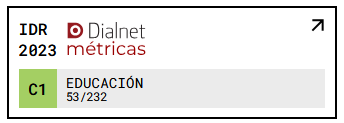Análisis de las situaciones de violencia entre iguales en educación primaria : diferencias en función del género y del curso
DOI:
https://doi.org/10.18172/con.623Palabras clave:
Violencia entre iguales, género, curso, Educación Primaria, prevenciónResumen
El objetivo del presente estudio fue conocer la relación entre las conductas de violencia entre iguales, el género y el curso, en Educación Primaria. Los participantes fueron 2.050 escolares de 8 a 13 años de 27 centros públicos y privado-concertados de Educación Primaria de la Comunidad de Madrid. La muestra fue diseñada para que representase a todo el alumnado escolarizado entre 3º y 6º curso de la región. El alumnado cumplimentó un cuestionario sobre distintas situaciones de violencia entre iguales. Los análisis factoriales revelaron la existencia de dos dimensiones: ‘violencia física y ataques a la propiedad’ y ‘violencia verbal y exclusión social’. Los chicos informaron sufrir y ejercer con mayor frecuencia que las chicas tanto la violencia física como la verbal-exclusión social. No hubo efecto del curso en las diferencias de género encontradas. Este trabajo nos proporciona una mejor comprensión de la violencia entre iguales en Educación Primaria, así como posibles orientaciones para su prevención.Descargas
Citas
Ararteko (2006). Convivencia y conflictos en los centros educativos. Vitoria: Ararteko.
Baldry, A. C. y Winkel F. W. (2003). Direct and vicarious victimization at school and at home as risk factors for suicidal cognition among Italian adolescents. Journal of Adolescence, 26, 703-716.
Blaya, C., Debarbieux, E. y Lucas Molina, B. (2007). La violencia hacia las mujeres y hacia otras personas percibidas como distintas a la norma dominante: el caso de los centros educativos. Revista de Educación, 342, 61-81.
Björkqvist, D., Lagerspetz, K. y Kaukiainen, A. (1992). Do girls manipulate and boys fight? Developmental trends in regard to direct and indirect aggression. Aggressive Behavior, 18, 117-127.
Block, J. H. (1983). Differential premises arising from differential socialization of the sexes: Some conjectures. Child Development, 54, 1335-1354.
Boulton, M. y Underwood, K. (1992). Bully/victim problems among middle school children. British Journal of Educational Psychology, 62, 73-87.
Cowie, H. (2000). Bystanding or standing by: Gender issues in coping with bullying in schools. Aggressive Behavior, 26, 85-97.
Crick, N. R. (1996). The role of overt aggression, relational aggression, and prosocial behavior in the prediction of children’s future social adjustment. Child Development, 67, 2317-2327.
Crick, N. R. y Grotpeter, J. K. (1995). Relational aggression, gender, and social-psychological adjustment. Child Development, 66, 710-722.
Crick, N. R. y Grotpeter, J. K. (1996). Children’s treatment by peers: Victims of relational and overt aggression. Development and Psychopathology, 8, 367-380.
Crick, N. R., Nelson, D. A., Morales, J. R., Cullerton-Sen, S. y Hickman, S. E. (2001). Relational aggression in childhood and adolescence. En J. Juvonen y S. Graham (Eds.), Peer harassment in school: The plight of the vulnerable and victimized (pp. 196-214). New York: Guilford.
Currie, C., Roberts, C., Morgan, A., Smith, R., Settertobulte, W., Samdal, O. y Barnekow, V. (Eds.) (2004). Young people’s health in context. Health Behaviour in School-aged Children (HSBC) study. Copenhague: WHO Publications.
Defensor del Pueblo (2000). Violencia escolar: el maltrato entre iguales en la Educación Secundaria Obligatoria. Madrid: Publicaciones del Defensor del Pueblo.
Defensor del Pueblo (2006). Violencia escolar: el maltrato entre iguales en la Educación Secundaria Obligatoria (1999-2006). Madrid: Publicaciones del Defensor del Pueblo.
Defensor del Menor de la Comunidad de Madrid (2006). Convivencia y confrontación entre iguales. Madrid: Publicaciones del Defensor del Menor de la Comunidad de Madrid.
Díaz-Aguado, M. J. (2005). La violencia entre iguales en la adolescencia y su prevención desde la escuela. Psicothema, 17, 549-558.
Díaz-Aguado, M. J., Martínez Arias, R. y Martín Seoane, G. (2004). Prevención de la violencia y lucha contra la exclusión desde la adolescencia. Volumen uno: La violencia entre iguales en la escuela y en el ocio: estudios comparativos e instrumentos de evaluación. Madrid: INJUVE.
Espelage, D., Bosworth, D. y Simon, T. (2000). Examining the social context of bullying behaviours in early adolescence. Journal of Counselling and Development, 78, 326-333.
Espelage, D., Holt, M. K. y Henkel, R. R. (2003). Examination of peer-group contextual effects on aggression during early adolescence. Child Development, 74, 205-220.
Garaigordobil, M. y Oñederra, J. A. (2009). Acoso y violencia escolar en la Comunidad Autónoma del País Vasco. Psicothema, 21, 83-89.
Knight, G. P., Guthrie, I. K., Page, M. C. y Fabes, R. A. (2002). Emotional arousal and gender differences in aggression. En J. Juvonen y S. Graham (Eds.), Peer harassment in school: The plight of the vulnerable and victimized (pp. 25-72). New York: Guilford.
Lucas Molina, B. (2008). Violencia escolar en Educación Primaria. Tesis Doctoral Inédita. Madrid: Universidad Complutense.
Martín Seoane, G., Pulido, R. y Vera, R. (2008). Maltrato entre iguales y exclusión social en la Comunidad de Madrid: análisis y posibilidades de intervención. Psicología Educativa, 14, 103-113.
Nansel, T. R., Overpeck, M., Pilla, R. S., Ruan, W. J., Simons- Morton, B. y Scheidt, P. (2001). Bullying behavior among US youth: Prevalence and association with psychosocial adjustment. The Journal of the American Medical Association, 285, 2094-2100.
Nansel, T., Craig, W., Overpeck, M., Saluja, G., Ruan, W. y the Health Behavior in School-Aged Children Bullying Analyses Working Group. (2004). Cross-national consistency in the relationship between bullying behaviors and psychosocial adjustment. Archives of Pediatrics y Adolescent Medicine, 158, 730-736.
Olweus, D. (1978). Aggression in the schools: bullies and whipping boys. Washington DC: Hemisphere (Wiley).
Olweus, D. (1998). Conductas de acoso y amenaza entre escolares. Madrid: Morata.
Olweus, D. (1999). Norway. En P. K. Smith, Y. Morita, J. Junger-Tas, D. Olweus, R. Catalano y P. Slee (Eds), The nature of school bullying. A cross-national perspective. London: Routledge.
Ortega, R. y Mora-Merchán, J. A. (2000). Violencia escolar: mito o realidad. Sevilla: Mergablum.
Owens, L. D. y Macmullin, C. E. (1995). Gender differences in aggression in children and adolescents in South Australian schools. International Journal of Adolescence and Youth, 6, 21-35.
Owens, L., Dali, A. y Slee, P. (2005). Sex and age differences in victimisation and conflict resolution among adolescents in a South Australian school. Aggressive Behavior, 31, 1-12.
Parke, R. D. y Slaby, R. G. (1983). The development of aggression. In P. Musen y E. M. Hetherington (Eds.), Handbook of child psychology: Vol. 4. Socialization, personality, and social development (pp. 547-641). New York: Wiley.
Pellegrini, A. D. (2002). Bullying and victimization in middle school: A dominance relations perspective. Educational Psychologist, 37, 151-163.
Pellegrini, A. D. y Long, J. (2002). A longitudinal study of bullying, dominance, and victimization during the transition from primary to secondary school. British Journal of Developmental Psychology, 20, 259-280.
Prinstein, M. J., Boergers, J. y Vernberg, E. M. (2001). Overt and relational aggression in adolescents: Social-psychological adjustment of aggressors and victims. Journal of Clinical Child Psychology, 30, 479-491.
Rigby, K. y Slee, P. T. (1999). Suicidal ideation among adolescent school children, involvement in bully/victim problems and perceived low social support. Suicide and Life-threatening Behavior, 29, 119-130.
Salmivalli, C. (2010). Bullying and the peer group: A review. Aggression and Violent Behavior, 15, 112-120.
Smith, P. K., Madsen, K. C. y Moody, J. C. (1999a). What causes the age decline in reports of school being bullied at school? Toward a developmental analysis of risks of being bullied. Educational Research, 41, 267-285.
Smith, P. K., Morita, Y., Junger-Tas, J., Olweus, D., Catalano, R., y Slee, P. (Eds) (1999b). The nature of school bullying. A cross-national perspective. London: Routledge.
Smith, P. K. y Sharp, S. (Eds.) (1994). School Bullying. Insights and perspectives. New York: Routledge.
Sullivan, K. (2000). Planning, philosophy, and policy. En K. Sullivan (Ed.), The anti-bullying handbook (pp. 9-39). New York: Oxford University Press.
Tapper, K. y Boulton, M. (2004). Sex differences in levels of physical, verbal, and indirect aggression amongst primary school children and their associations with beliefs about aggression. Aggressive Behavior, 30, 123-145.
Toldos, M. P. (2005). Sex and age differences in self-estimated physical, verbal and indirect aggression in Spanish adolescents. Aggressive Behavior, 31, 13-23.
Vaillancourt, T., Brendgen, M., Boivin, M. y Tremblay, R. E. (2003). A longitudinal confirmatory factor analysis of indirect and physical aggression: Evidence of two factors over time? Child Development, 74, 1628-1638.
Veenstra, R., Lindenberg, S., Munniksma, A. y Dijkstra, J. (2010). The complex relation between bullying, victimization, acceptance, and rejection: Giving special attention to status, affection, and sex differences. Child Development, 81, 510-516.
Whitney, I. y Smith, P. K. (1993). A survey of the nature and extend of bullying in junior/middle and secondary schools. Educational Research, 35, 3-25.
Descargas
Publicado
Cómo citar
Número
Sección
Licencia
El autor o autora conserva todos los derechos sobre su artículo y cede a la revista el derecho de la primera publicación, no siendo necesaria la autorización de la revista para su difusión una vez publicado. Una vez publicada la versión del editor el autor está obligado a hacer referencia a ella en las versiones archivadas en los repositorios personales o institucionales.
El artículo se publicará con una licencia Creative Commons de Atribución, que permite a terceros utilizar lo publicado siempre que se mencione la autoría del trabajo y la primera publicación en esta revista.
Se recomienda a los autores/as el archivo de la versión de editor en repositorios institucionales.













